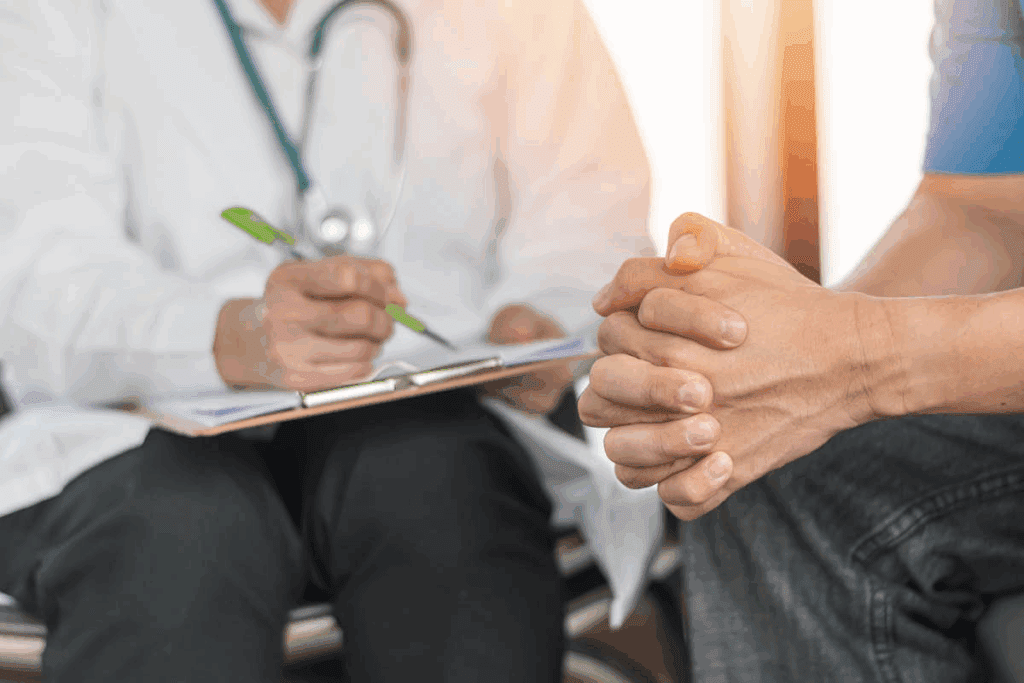Last Updated on November 25, 2025 by Ugurkan Demir

Bladder diseases are a big problem worldwide, affecting millions. They can really hurt someone’s quality of life. It’s important to know the symptoms and treatment options.
We need to tackle urinary bladder disorders and bladder illnesses with care. From simple infections to serious diseases like cancer, getting help fast is key.
It’s important for both patients and doctors to understand these conditions. By learning about common bladder diseases and treatments, we can improve healthcare. This way, we can offer better support and care.

It’s important to understand bladder diseases to tackle their global impact. These diseases include infections, cancers, and functional disorders. They affect millions worldwide, impacting their quality of life and healthcare systems.
Bladder diseases vary globally, with some conditions more common in certain areas or groups. For example, bladder cancer is a big issue in developed countries, with about 540,000 new cases each year. It’s more common in men and older adults.
Urinary tract infections (UTIs) and overactive bladder syndrome also have big patterns. UTIs are common worldwide, affecting people of all ages. Overactive bladder, causing frequent need to urinate, affects many, mostly the elderly.
Age, gender, and where you live are big factors in bladder disease prevalence.
Several factors increase the risk of bladder diseases. Smoking is a big risk for bladder cancer, exposing the bladder to harmful chemicals. Working with chemicals in industries like dye, rubber, and paint also raises the risk.
Knowing these risk factors is key to preventing and catching bladder diseases early. By tackling these risks, we can lessen the global impact of these conditions.

Bladder cancer happens when cells in the bladder lining grow too much and form tumors. These tumors can spread to other tissues. It’s a big health issue worldwide, with different types and treatments.
There are three main types of bladder cancer: urothelial carcinoma, squamous cell carcinoma, and adenocarcinoma. Urothelial carcinoma makes up about 90% of cases. Knowing the stage of bladder cancer is key for treatment and outlook.
Bladder cancer stages range from stage 0 to stage IV. Stage 0 has cancer in the bladder lining only. Stage IV means the cancer has spread far away. The right stage helps pick the best treatment.
| Stage | Description |
| Stage 0 | Cancer cells are found only in the bladder lining. |
| Stage I | Cancer has grown into the layer below the bladder lining but not to the bladder muscle. |
| Stage II | Cancer has grown into the bladder muscle. |
| Stage III | Cancer has grown through the bladder muscle and into the layer of fatty tissue surrounding the bladder. |
| Stage IV | Cancer has spread to distant parts of the body. |
Spotting bladder cancer early can lead to better treatment results. Look out for hematuria (blood in urine), needing to pee a lot, and pain while peeing. If you notice these signs, see a doctor right away.
These symptoms can also mean other things. But, a doctor’s check-up is needed to find out for sure.
Treatment for bladder cancer varies based on the type, stage, and patient’s health. Options include surgery, chemotherapy, immunotherapy, and radiation. Early-stage bladder cancer might get less invasive treatments. But, more serious cases might need stronger treatments.
We aim to give the best care for bladder cancer patients. We use the newest treatments and focus on the patient’s needs.
UTIs are common bacterial infections that affect the urinary system, including the bladder. They happen when bacteria from the urethra enter the bladder and grow.
The main cause of UTIs is Escherichia coli (E. coli), a bacterium in the gut. Other bacteria can also cause these infections. Several factors can raise your risk of getting a UTI, such as:
Symptoms of UTIs can vary but often include:
Severe cases may present with fever, chills, or blood in the urine, indicating a possible kidney infection.
UTIs are usually treated with antibiotics. The antibiotic choice depends on the bacteria causing the infection and the patient’s history. Common antibiotics include:
| Antibiotic | Dosage | Duration |
| Trimethoprim/Sulfamethoxazole | 160/800 mg twice daily | 3 days |
| Nitrofurantoin | 100 mg twice daily | 5-7 days |
| Ciprofloxacin | 250 mg twice daily | 3 days |
To prevent UTIs, drink plenty of water, practice good hygiene, and urinate after sex.
Overactive bladder syndrome is more than just needing to pee a lot. It’s a condition that really affects your daily life. Involuntary bladder contractions cause you to suddenly and often need to go to the bathroom.
The causes of overactive bladder syndrome can be tricky. They involve both the brain and muscles. Neurological conditions like Parkinson’s disease, stroke, and multiple sclerosis can mess with bladder control. Weak pelvic floor muscles are another factor.
To diagnose overactive bladder syndrome, doctors look for specific symptoms. These include urgency, needing to pee a lot, and waking up at night to go. Urgency and urinary incontinence are key signs. Doctors might use bladder diaries and tests to check how well the bladder works.
Treating overactive bladder syndrome often means using many different methods. This includes changing your lifestyle, trying behavioral therapies, and using medicines. Bladder training helps you hold your pee longer and feel better. Medicines like anticholinergics and beta-3 adrenergic agonists relax the bladder muscle.
Physical therapy for the pelvic floor muscles can also help. For those who don’t get better with these treatments, options like neuromodulation or botulinum toxin injections might be suggested.
Understanding interstitial cystitis/bladder pain syndrome is complex. It involves persistent pelvic pain and bladder pressure. This condition greatly affects the quality of life for those who have it.
The exact cause of interstitial cystitis/bladder pain syndrome is not known. But, several theories have been proposed. These include:
“The pathophysiology of interstitial cystitis is complex and likely involves multiple factors,” as noted by recent studies. This makes it hard to diagnose and treat.
Symptoms of interstitial cystitis/bladder pain syndrome vary widely. This makes diagnosis tricky. Common symptoms include:
Diagnosing this condition often involves ruling out other causes. A thorough diagnostic approach is key for accurate diagnosis.
Treatment for interstitial cystitis/bladder pain syndrome is often a mix of therapies. We suggest:
Personalized treatment plans are vital. What works for one patient may not work for another. “A tailored approach to treatment can significantly improve the quality of life for patients with interstitial cystitis,” clinical experts say.
Bladder stones are hard mineral deposits in the bladder. They can cause pain and make it hard to urinate. It’s important to know how they form, what symptoms they cause, and how to treat them.
Bladder stones form when urine is too concentrated. This can happen if you don’t drink enough water or have other health issues. Risk factors include urinary tract infections, bladder blockages, and neurogenic bladder. Men with enlarged prostate glands are more likely to get bladder stones.
Knowing these risk factors helps prevent and catch bladder stones early. We’ll look at the main factors that lead to bladder stone formation, including:
Bladder stones can cause pain while urinating, needing to urinate often, and trouble starting to urinate. Sometimes, they don’t show any symptoms. Doctors use ultrasound or CT scans to diagnose bladder stones, along with a detailed medical history and physical exam.
The symptoms can vary, but common ones are:
Treatment for bladder stones depends on their size and symptoms. Small stones might pass on their own, while bigger ones might need medical help. This could include medications to dissolve the stones or surgery.
To prevent stones from coming back, it’s important to address the causes. This includes drinking more water, managing urinary tract infections, and treating bladder blockages. Here are some preventive steps:
Understanding bladder stones, their symptoms, and treatment helps manage the condition and prevent future problems.
Millions worldwide face urinary incontinence, a condition that affects bladder control. It leads to involuntary urine leakage. This can greatly affect daily life and social interactions.
Urinary incontinence has several types, with stress, urge, and mixed being the most common.
Knowing the type of urinary incontinence is key to finding the right treatment.
Diagnosing urinary incontinence requires a detailed assessment:
These steps help healthcare providers find the cause and create a treatment plan.
Treatment for urinary incontinence varies based on the type, severity, and overall health. Options include:
Understanding urinary incontinence helps individuals work with healthcare providers to find effective treatments. This improves their quality of life and reduces the impact of bladder control problems.
When the nervous system can’t control the bladder, neurogenic bladder happens. This leads to big problems with urination. It’s caused by many neurological disorders that mess up the brain’s control over the bladder.
Many neurological conditions can cause neurogenic bladder. These include spinal cord injuries, multiple sclerosis, Parkinson’s disease, and stroke. Each can damage the nerves that control the bladder, causing urinary retention or incontinence.
For example, spinal cord injuries can stop the brain from talking to the bladder. This makes the bladder either too active or too slow. Multiple sclerosis can also damage nerve fibers, causing problems with bladder communication.
Symptoms of neurogenic bladder vary a lot. They depend on the condition and how much nerve damage there is. Common symptoms are frequent urination, urgency, and urge incontinence. Some people have trouble starting to urinate or emptying the bladder fully.
If not treated, neurogenic bladder can cause UTIs, bladder stones, and even kidney damage. It’s important to watch it closely and manage it well to avoid these problems and keep a good quality of life.
Managing neurogenic bladder needs a team effort. This includes medication, catheterization, and behavioral therapies. Medications can relax the bladder or help control it. Using a catheter helps empty the bladder fully and lowers infection risk.
Behavioral therapies like timed voiding and pelvic floor exercises can also help. Making lifestyle changes, like what you eat and how much you drink, is key too. These changes can control symptoms and improve life quality.
With a good management plan, people with neurogenic bladder can greatly improve their urinary health and overall well-being.
Bladder diseases cover a wide range of conditions that affect our urinary health and overall well-being. It’s important to manage and treat these conditions well to keep our bladders healthy and prevent problems.
Early detection and proper treatment can greatly improve bladder health outcomes. We need to keep researching, educating, and raising awareness to better care for those with bladder diseases. By improving prevention and care, we can lessen the impact of these conditions on people and healthcare systems.
We’ve talked about the complexities of bladder diseases, including bladder cancer, urinary tract infections, overactive bladder, and neurogenic bladder. It’s key to understand these conditions and their effects on urinary health. This knowledge helps us create effective treatment plans and improve patient outcomes.
By focusing on bladder health and urinary health, we can improve how we manage and treat bladder diseases. This includes medical treatments, patient education, and support. As we continue, exploring new ways to prevent and care for bladder diseases is vital. This will help improve the lives of those affected.
Common bladder diseases include bladder cancer and urinary tract infections. Other issues are overactive bladder syndrome and interstitial cystitis/bladder pain syndrome. Bladder stones, urinary incontinence, and neurogenic bladder are also common.
Symptoms vary but often include frequent urination and painful urination. Blood in the urine, incontinence, and pelvic pain are also signs.
Doctors use a medical history and physical exam to diagnose bladder diseases. Imaging tests and lab tests like urinalysis and cystoscopy are also used.
Risk factors include smoking and exposure to chemicals at work. Age, family history, and certain conditions like diabetes are also risks.
Antibiotics treat urinary tract infections. Good hygiene, staying hydrated, and urinating after sex help prevent them.
Treatments include bladder training and medications. Pelvic floor exercises are also helpful.
Management involves medications, dietary changes, and nerve stimulation therapy. A multimodal approach is key.
Neurogenic bladder results from neurological conditions. These include spinal cord injuries, multiple sclerosis, and Parkinson’s disease.
Preventing bladder stones means staying hydrated and avoiding certain foods. Managing medical conditions is also important.
Options include medications and pelvic floor exercises. Surgical procedures like sling procedures are also available.
Managing symptoms involves lifestyle changes and medical treatments. Dietary modifications and fluid management are key. Medications and therapy are also important.
National Center for Biotechnology Information. 7 Common Bladder Diseases Symptoms and Treatment Options. Retrieved from https://pubmed.ncbi.nlm.nih.gov/22898455/
Subscribe to our e-newsletter to stay informed about the latest innovations in the world of health and exclusive offers!